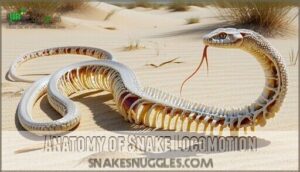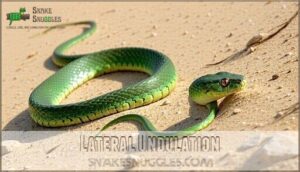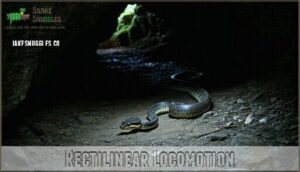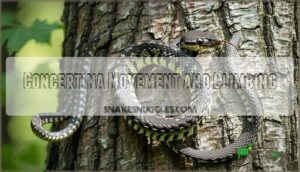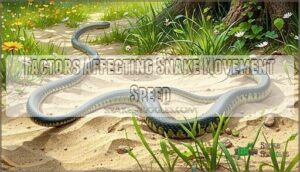This site is supported by our readers. We may earn a commission, at no cost to you, if you purchase through links.

Snakes use four main movement patterns: serpentine undulation (that classic S-shaped wiggle you’ve seen), concertina movement (like an accordion stretching and contracting), sidewinding (perfect for sandy terrain), and rectilinear motion (straight-line crawling using belly scales).
Their muscular system works with specialized scales to create friction and propulsion, turning their flexible spine into a sophisticated suspension system.
Each movement type serves different purposes—lateral undulation for speed, sidewinding to prevent sinking in sand, concertina for tight spaces, and rectilinear for silent stalking.
These adaptations reveal fascinating biomechanical secrets that engineers are now studying.
Their study of these movements can lead to new innovations and a deeper understanding of how snakes thrive in various environments, making them a subject of great interest in the fields of biology and engineering, with potential applications in robotics and other areas.
Table Of Contents
- Key Takeaways
- Snake Movement Patterns
- How Snakes Actually Move
- Anatomy of Snake Locomotion
- Types of Snake Movement
- Snake Climbing Techniques
- Snakes Without Legs
- Factors Affecting Snake Movement Speed
- Snake Movement and Health
- Snake Locomotion in Different Environments
- Locomotory Organs and Mechanisms
- Frequently Asked Questions (FAQs)
- How do snakes move?
- How does a snake move gradually toward its victim?
- Do snakes move in a serpentine way?
- Why do snakes move in a straight line?
- Do snakes crawl or slither?
- How do snakes move without arms or legs?
- How do snakes climb?
- How do rattlesnakes move?
- How do tree snakes move from branch to branch?
- Do snakes need legs to move?
- Conclusion
Key Takeaways
- You’ll find snakes use four main movement patterns: serpentine undulation (S-shaped waves), concertina movement (accordion-like stretching), sidewinding (diagonal rolling for sandy terrain), and rectilinear motion (straight-line crawling using belly scales).
- You can see how their specialized belly scales work like nature’s grip pads, creating directional friction that allows them to grab backward while sliding forward smoothly across any surface.
- You’ll notice their flexible spine with up to 400 vertebrae works with powerful muscles and ribs to create wave-like contractions that propel them efficiently without needing legs.
- You can observe how each movement type serves specific purposes—lateral undulation for speed on flat surfaces, sidewinding to avoid sinking in sand, concertina for climbing and tight spaces, and rectilinear for silent stalking.
Snake Movement Patterns
You might think snakes would struggle to get around without legs, but their movement patterns are nothing short of remarkable.
Looking at this fascinating content about snake locomotion, here’s a short, engaging blockquote that captures the same tone:
Nature’s legless athletes prove that sometimes the most elegant solutions come without conventional limbs.
Using a mix of muscle coordination, body curves, and belly scales, they’ve mastered four main ways to slither across almost any surface.
Serpentine Movement
Serpentine movement, or lateral undulation, is the superstar of snake locomotion.
Imagine a snake performing a graceful aquatic serpentine dance—its body forms S-shaped waves, pressing against surfaces for smooth propulsion.
This method is versatile, working wonders on uneven terrains or in water, thanks to its evolutionary origins.
- Maximizes surface friction for control
- Supports arboreal serpentine climbing and swimming
- Adapts speed variations for hunting or escape
- Relies on snake body mechanics for flexibility
- Efficiently conserves energy during movement
It’s a perfect blend of elegance and practicality!
Concertina Movement
Picture a snake scaling a tree or squeezing through a narrow tunnel—that’s the concertina method in action. This type of snake movement is like watching an accordion stretch and compress. The snake anchors part of its body, pulls the rest forward, then repeats. It’s a masterclass in snake body mechanics, showcasing grip strength and precise snake muscle action.
This method shines in confined spaces or vertical climbs, making it an arboreal adaptation for some species. But it’s not energy-efficient on open terrain, where other modes work better. The evolutionary advantages of the concertina method highlight how snakes thrive in diverse environments.
| Feature | Benefit | Limitation |
|---|---|---|
| Grip Strength | Navigates vertical spaces | Energy-intensive |
| Snake Muscle Action | Precise control in tight areas | Slow on flat ground |
| Confined Spaces | Ideal for burrows | Poor for open areas |
| Arboreal Adaptation | Climbing trees effectively | Limited speed |
Sidewinding Movement
Sidewinding is a brilliant desert adaptation, helping snakes like the sidewinder rattlesnake master sandy terrain.
By lifting parts of their bodies and forming J-shaped tracks, they reduce friction and avoid sinking.
This snake locomotion, driven by precise muscle control and unique belly scales, achieves impressive sidewinding speeds. It’s like nature’s way of saying, “Why walk when you can slither sideways with style?”
Rectilinear Movement
Rectilinear locomotion, also called the caterpillar method, is the masterclass in snake movement when straight-line motion is the goal.
Large snakes like pythons use this technique to move quietly and smoothly. Muscles contract, belly scales grip the ground, and linear progression happens with surprising energy efficiency.
Unlike flashier modes, it’s all about precision and stealth.
- Unique facts:
- Perfect for tight spaces
- Common in boas and pythons
- Slow but steady motion
- Muscles do the heavy lifting
- Ground gripping for traction
Factors Influencing Movement Patterns
Snake movement patterns depend on size, species, terrain, and environment.
Larger snakes, like pythons, embrace rectilinear locomotion for steady, straight gliding, while smaller ones favor lateral undulation for quick, agile navigation.
Terrain impacts movement—desert-dwelling snakes adopt sidewinding to master loose sand, and climbers use concertina techniques for tree trunks.
Friction is key, helping belly scales grip surfaces during movement.
These snake locomotion mechanisms showcase how millions of years of evolution have perfected their incredible, legless ability to conquer diverse habitats.
How Snakes Actually Move
You might think snakes simply slither, but their movement is a scientific marvel driven by powerful muscles and specialized belly scales.
By gripping surfaces and redistributing their weight, snakes turn their legless bodies into efficient, flexible engines of motion.
Role of Muscles and Scales
Snake locomotion is a masterclass in coordination.
Snake movement is nature’s engineering masterpiece—pure biomechanical brilliance without a single leg needed.
Snake muscles contract in waves, paired with rib movement and spinal flexibility, creating undulation power that propels them forward.
Snake scales grip surfaces with remarkable scale friction, acting like tiny cleats for traction.
This muscle tone and snake scale function work together seamlessly, allowing snakes to slither across rocks, sand, or even climb trees, like watching nature’s most efficient conveyor belt in action with undulation power.
Belly Scale Movement and Friction
A snake’s movement depends heavily on scale friction control. Its ventral scales, with unique microstructures, grip surfaces like a climber’s hands.
Here’s how they work:
- Substrate grip variation adjusts to terrain—rocks, grass, or sand.
- Scale material properties enhance traction.
- Evolutionary scale adaptations reduce energy loss.
- Scales resist backward slipping, aiding forward motion.
- Snake slithering appears effortless, even in the rectilinear method.
It’s nature’s engineering masterpiece!
Propulsion Techniques
To move without legs, snakes rely on clever propulsion techniques that combine muscle contraction, scale friction, and spinal flexibility.
They master three key methods:
- Serpentine Method: Creates S-shaped body curvature, pushing off surfaces for fluid snake motion.
- Sidewinding: Rolls sideways, perfect for sandy or unstable terrain, minimizing heat contact.
- Concertina Motion: Anchors part of the body, stretching forward like an accordion for tight spaces.
Snake locomotion is pure engineering brilliance!
Weight Redistribution
In the context of snake locomotion, weight redistribution is their secret weapon.
By constantly adjusting their center of gravity, snakes maintain balance control and friction management, even on tricky surfaces like sand or rocks.
Think of it as a graceful dance where their body angles and inertia effects work together seamlessly.
For instance, during lateral undulation, side muscles push against the ground, while rectilinear movement relies on core muscles for steady, straight motion.
In climbing or tight spaces, belly muscles anchor and stretch like an accordion.
This intricate snake biomechanics, blending snake muscle function with precise weight shifts, turns their anatomy into a masterpiece of efficient movement.
Anatomy of Snake Locomotion
You might think snakes are all muscle, but their movement relies on a fascinating mix of bones, muscles, and scales working together.
Their flexible spines and specialized belly scales create the perfect system for slithering, climbing, and even gliding.
Skeletal Structure
The snake skeletal structure is like a finely-tuned machine, built for adaptability.
With an impressive vertebral count—up to 400 bones—its spine offers unmatched spinal flexibility.
Each vertebra connects to ribs through precise rib articulation, creating a frame that’s both sturdy and agile.
These curved ribs shield essential organs while aiding movement. Add bone density and clever skull adaptations, and you’ve got a creature designed for slithering, climbing, and even burrowing.
It’s nature’s way of proving you don’t need legs to move gracefully!
Muscle Structure and Movement
Muscles are the unsung heroes of snake movement, working in perfect harmony with their skeletal structure.
Here’s how:
- Muscle Fiber Types: Thousands of segmented fibers create flexibility for twists and turns.
- Rib Muscle Coordination: Muscles connect ribs and spine, powering slithering and climbing.
- Contraction Mechanisms: Efficient contractions propel snakes forward, conserving energy.
This scale-muscle connection transforms snakes into fluid, legless wonders of nature!
Role of The Spine in Locomotion
Picture the spine as a snake’s secret weapon for movement—a flexible marvel with hundreds of vertebrae working like a finely-tuned machine.
This high vertebrae count, paired with precise muscle attachment, makes the musculoskeletal system a powerhouse of locomotion efficiency.
Whether gliding straight in rectilinear motion or twisting into S-shaped loops during lateral undulation, spinal flexibility is key.
It’s like having a built-in suspension system, adapting to every terrain.
From tight bends in the concertina technique to steady, straight movements, the spine’s evolution guarantees snakes remain masters of motion, showcasing the brilliance of snake anatomy in every slither.
Importance of Belly Scales
Belly scales are like a snake’s built-in traction pads, vital for smooth and efficient movement.
These specialized scales enhance scale friction and provide the perfect climbing grip on various surfaces, from rocks to tree trunks.
Their surface adhesion guarantees seamless locomotion efficiency, whether slithering across sand or gliding through dense grass.
This marvel of evolutionary adaptations showcases how snake anatomy turns simple scales into powerful tools, making snake locomotion a fascinating dance of friction control and precision.
Types of Snake Movement
You might think snakes would struggle to get around without legs, but they’ve mastered four fascinating ways to move.
Each method, from the wavy lateral undulation to the inchworm-like rectilinear motion, is perfectly adapted to their needs and environment.
Lateral Undulation
Lateral undulation, or the serpentine slither, is how snakes effortlessly master movement on land and in water.
They create smooth, S-shaped waves using:
- Aquatic Undulation, offering seamless glides through water.
- Muscle Coordination, powering vertebrae twists with precision.
- Scale Grip, anchoring against terrestrial surfaces for traction.
- Speed Variations, allowing swift or steady progress.
This sideways movement is a brilliant evolutionary advantage, transforming flexibility and strength into unmatched snake locomotion.
Sidewinding
Sidewinding is the ultimate desert adaptation, letting snakes thrive on hot, loose sand.
Unlike typical movements, this zigzag marvel lifts sections of the body off the ground, minimizing heat exposure while maintaining traction. The result? Effortless navigation of dunes and slippery terrain.
Here’s a closer look at sidewinding:
| Feature | Details |
|---|---|
| Efficiency | Reduces body contact with hot sand. |
| Speed | Achieves rapid, controlled movement. |
| Robotics Use | Inspires desert-ready robot designs. |
This movement isn’t just practical—it’s a demonstration of evolutionary origins, showcasing snake locomotion at its smartest!
Rectilinear Locomotion
Rectilinear movement, also called the Caterpillar Method, is a slow, stealthy form of straight-line motion perfect for large snakes like boas and pythons.
Instead of bending, snakes use precise muscle contractions and ground-gripping belly scales to glide forward smoothly.
- Ideal for narrow spaces or stable terrain.
- Common in snake locomotion for heavy-bodied species.
- Relies on straightline movement for sneaking up on prey.
- Avoids the dramatic curves of concertina movement.
- Perfect for conserving energy while staying undetected.
Comparison of Different Snake Movements
Snakes have mastered movement in ways that would make even gymnasts jealous. Each style of snake locomotion is designed for specific needs.
Lateral undulation, the most common, is like a slithery sprint, perfect for speed on flat surfaces. Sidewinding seems like a quirky sideways dance, ideal for sandy or slippery terrain where minimizing friction is key. The concertina method works like an accordion, helping snakes climb or navigate tight spaces with precision. Finally, rectilinear movement—a slow, steady glide—is favored by larger snakes, offering low-energy, straight-line travel.
| Movement Style | Terrain | Speed | Adaptation |
|---|---|---|---|
| Lateral Undulation | Flat surfaces | Fast | Efficient propulsion |
| Sidewinding | Sand, mud | Moderate | Heat-resistant, low drag |
| Concertina Movement | Narrow spaces | Moderate | Precise grip |
| Rectilinear Movement | Tight, flat spaces | Slow |
Energy-saving glide.
From quick bursts to deliberate crawls, these methods highlight snakes’ evolutionary advantages in terrain adaptation and energy efficiency.
Snake Climbing Techniques
You might think climbing without legs sounds impossible, but snakes make it look effortless.
Using their powerful muscles and specialized belly scales, they grip surfaces tightly, inching upward with remarkable precision.
Concertina Movement and Climbing
Picture an accordion in motion—that’s concertina locomotion in action! This snake movement technique shines when tackling vertical surfaces, showcasing incredible grip strength and control.
Species with arboreal adaptations, like the Timber Rattlesnake, use this method to conquer trees and uneven terrain with ease.
Here’s how it works: parts of the snake’s body anchor firmly, creating a secure hold, while the rest stretches forward, inching upward in precise, controlled motions.
This strategy makes efficient climbing without wasting energy, making it ideal for slow, steady ascents.
Whether it’s traversing narrow crevices or scaling tough terrains, concertina locomotion proves snakes have mastered climbing techniques with finesse and adaptability.
Amazing, right?
Role of Belly Scales in Climbing
In the context of climbing, belly scales act like built-in climbing gear.
These specialized ventral scales, or scutes, grip surfaces much like nature’s Velcro.
Made from tough keratin, they maximize scale friction as a snake presses against rough, vertical surfaces.
It’s a clever evolutionary advantage, giving snakes the ability to conquer even tricky terrains.
You can even find specialized snake scutes designed for better grip.
By adapting their arboreal grip and surface contact, snakes seamlessly shift their weight, ensuring a firm hold.
This unique climbing adaptation highlights their mastery of movement without limbs, proving once again that snakes don’t need legs to scale tall obstacles or impress onlookers.
Snake Species That Can Climb
In regards to snake climbing, some species showcase incredible adaptations.
Green tree pythons, for instance, excel at maneuvering vertical surfaces. They rely on gripping branches firmly, blending strength and flexibility.
Here’s how their climbing biomechanics shine:
- Arboreal adaptations make climbing second nature.
- Grip strength makes balance on uneven branches possible.
- Evolutionary advantages enable survival in forest habitats.
Their skill turns climbing into a true art form.
Adaptations for Arboreal Snakes
Life in the trees demands some incredible skills, and arboreal snakes have them all figured out.
- Arboreal grip: Belly scales act like tree-climbing boots, gripping branches for stability.
- Branch bridging: Their flexible, elongated bodies stretch across gaps like nature’s tightrope walkers.
- Tail usage: A prehensile tail serves as an anchor for vertical climbing, while also aiding balance.
Now that’s snake movement mastery!
Snakes Without Legs
You might think snakes are at a disadvantage without legs, but their unique bodies are built perfectly for an efficient and fascinating range of motion.
Using muscles, flexible spines, and specialized belly scales, they glide, climb, and even swim with surprising ease, demonstrating their efficient adaptation to their environment.
Evolution of Limbless Snakes
Early snake ancestors weren’t the smooth movers you know today—they had small limbs.
Over millions of years, evolutionary pressures, like burrowing and stealth hunting, favored legless movement.
Fossil evidence shows some ancestral forms even had tiny hind legs before fully adapting to their now-iconic slither.
Genetic changes gradually silenced limb-forming genes, shedding unnecessary appendages.
This shift boosted agility and allowed snakes to squeeze through tight spaces, ambush prey, and thrive in diverse habitats.
Evolution made snakes true masters of movement.
Advantages of Legless Movement
Going legless gives snakes a major edge in agility.
Their streamlined shape and legless locomotion help them master rough terrain and confined spaces with ease.
By traversing obstacles effortlessly, they’re space efficiency experts, using terrain adaptation to sneak past predators or ambush prey.
This evolutionary benefit reduces injury risks, too, letting snakes slither stealthily where others can’t, which even robotics engineers find inspiring!
Unique Features of Snake Bodies
Ever notice how snakes make legless locomotion look so easy?
Their flexible spine and rib structure provide unmatched range and balance.
With ventral scales creating friction and muscle control fine-tuning movement, snakes master crawling, gliding, and undulation.
This mix of precision and adaptability fuels their stunning snake locomotion styles—like creeping or slithering—on nearly any surface, with zero legs needed!
Comparison With Other Animals
Snake movement defies expectations, showcasing a sleek mastery compared to other animals.
Let’s break it down:
- Limbless movement without legs rivals fish in water or birds in air.
- Worms share similar motion but lack the snake’s grace and precision.
- Terrestrial snakes use rectilinear locomotion to outperform burrowing animals and insects.
- Their strong ribs and specialized scales offer unmatched flexibility.
- Aquatic adaptations let snakes glide effortlessly, mirroring evolutionary convergence.
Snakes, indeed, make locomotion look like an art form in nature!
Factors Affecting Snake Movement Speed
You’d be surprised how many factors determine how fast a snake can slither.
From its size and muscle strength to the terrain it crosses, every detail plays a role in shaping its speed. complete concepts
Body Size and Movement Speed
In the context of snake speed, size differences make a big impact.
Smaller snakes often display impressive agility, darting through their habitats like tiny athletes.
Meanwhile, larger snakes face a tug-of-war between their hefty frames and muscle power.
Yet, thanks to clever evolutionary adaptations, like specialized scales and movement patterns, even big snakes hold their own.
Speed differences also hinge on snake agility and habitat influence; some species prioritize stealth over speed.
Ultimately, snake movement speed is a careful balance of efficiency, power, and adaptability.
Environmental Factors and Speed
Where snakes live can dramatically impact their speed! Terrain challenges like sandy deserts call for sidewinding, while humid forests slow down movement with dense undergrowth.
Temperature effects also shape muscle performance, influencing snake movement efficiency in heat or cold.
- Shifting sands demand minimal friction for quicker pace.
- Rocky habitats promote agile climbing and slithering.
- Seasonal variation changes terrain and prey availability, tweaking speed and environmental adaptation skills.
Hunting and Escaping Strategies
When it’s time to eat or avoid being eaten, snake movement techniques become marvels of efficiency.
They use ambush predation, lying in wait with the stealth of a ninja, striking prey in milliseconds.
Some favor venom usage for a quick takedown, while others rely on constriction tactics to overpower.
For escape, camouflage escape blends them into surroundings, or they engage speed evasion, zig-zagging and sidewinding away.
Every move showcases their mastery of snake hunting and survival.
Comparison of Snake Speeds
Not all snake speeds are created equal—it’s like nature adapted each species for its environment.
Speed champions like the Sidewinder Rattlesnake use sidewinding to hit an impressive 18 mph, proving there’s efficiency in moving sideways across hot, shifting sands.
On the other hand, heavyweight snakes, like pythons, favor slow but steady rectilinear movement.
Size plays a key role—smaller, leaner snakes are faster, while larger, bulkier species prioritize control over speed.
Terrain impacts snake movement too; deserts demand speed and minimal surface contact, while dense forests require agility.
Strike speed is another marvel—Black Mambas combine rapid bursts and serpentine grace to outpace danger.
Snake movement techniques are a masterclass in environmental adaptation.
Snake Movement and Health
When a snake isn’t moving quite right, it can reveal a lot about its health.
Understanding how movement works helps you spot issues early, ensuring the snake stays in tip-top shape.
Indicators of Healthy Movement
Healthy snake locomotion is all about graceful, fluid motion and a powerful connection to the ground.
You can spot it when the snake displays:
- Smooth motion: Effortless curves without hesitation.
- Consistent speed: Steady, energy-packed gliding.
- Adequate grip: Firm belly scales gripping surfaces like Velcro.
- Proper posture: Balanced body with a full range of movement.
These traits reveal strong coordination between spine, muscles, and scales.
Signs of Unhealthy Movement
Spotting unusual movements in your sleek companion can be tricky, but some signs are hard to miss:
- Lethargy or unresponsiveness hints at energy or health issues.
- Erratic movement like twitches or spasms may signal neurological troubles.
- Weakness, such as a limp body or reduced grip, often points to muscle atrophy.
Keep an eye out for spinal deformities or scale abnormalities—these could suggest injury or illness affecting your snake’s locomotion and behavior.
Factors Affecting Movement and Health
Movement in snakes is a balancing act between nature and nurture.
From size limitations to species variations, every snake adapts uniquely to its environment. Terrain plays a big role—desert sands call for sidewinding, while dense forests demand concertina skills.
Activity levels and health impacts also shape their movement. If a snake struggles, it could signal issues in its adaptation or friction control mechanisms.
Think of them as athletes fine-tuning their craft for survival. Here’s a quick breakdown:
Observing Movement for Health Checks
Keeping your snake healthy isn’t just about feeding—it’s about spotting subtle changes in how they move.
Regularly observing their movement can reveal a lot about their well-being.
Here’s a simple health checklist:
- Watch for smooth, flowing movement patterns (no jerks or stiffness).
- Test their posture by gently flipping them; they should right themselves with ease.
- Feel for firm muscle tone, avoiding areas that seem unusually soft or weak.
- Check if their grip on surfaces is strong and consistent during climbing or crawling.
- Notice any signs of coordination issues or irregular snake kinematics, like uneven movements.
Movement abnormalities like hesitation or strange snake gait might hint at scale condition problems or deeper muscle or neurological concerns.
Use a snake health checklist to monitor your snake.
Call your vet when in doubt!
Snake Locomotion in Different Environments
You’ll find snakes moving in almost every type of environment, from scorching deserts to dense forests and even underwater.
Their unique body structure and movement methods let them travel across sand, water, and trees with impressive skill, utilizing their adaptability to thrive in various ecosystems, and their ability to navigate through dense forests.
Desert Snakes and Sidewinding
Imagine crossing scorching sand without frying your feet—desert snakes do just that with sidewinding mechanics. This unique snake locomotion showcases their desert adaptations, letting them glide diagonally like living zigzagging ribbons.
By minimizing ground contact, they expertly manage sand traction and reduce energy expenditure. One iconic species, the Saharan horned viper, uses this technique to slither gracefully across dunes, avoiding the blazing heat.
Watching their hypnotic J-shaped movements makes you rethink what true mastery of the desert really looks like, showcasing their ability to glide diagonally and their desert adaptations.
Water Snakes and Lateral Undulation
Water snakes are true artists of movement, gliding effortlessly through their aquatic habitats.
They rely on lateral undulation to swim with grace and speed, displaying remarkable aquatic adaptations.
Here’s how they achieve such undulation efficiency:
- Form smooth S-shaped waves for streamlined swimming.
- Harness specialized belly scales to grip and push water.
- Use precise muscle control to optimize swimming speed.
- Leverage evolutionary advantages for seamless navigation.
This technique transforms snake movement into fluid artistry, showcasing their mastery of underwater locomotion!
Arboreal Snakes and Concertina Movement
Mastering the art of tree climbing, arboreal snakes rely on concertina movement to navigate branches with precision.
By bunching their bodies like a coiled spring, they anchor themselves securely, using grip strength from belly scales to hold onto varying branch diameters.
These specialized scales act as nature’s climbing gear, providing friction and control on uneven surfaces.
Stretching forward, they steadily progress, mimicking rope-climbing techniques.
Beyond survival, their anatomy, fine-tuned over millennia, highlights evolutionary advantages in arboreal hunting.
Whether slithering through dense canopies or adjusting to different surfaces, their movement showcases remarkable adaptability and climbing finesse unique to tree snake anatomy.
Environmental Adaptations for Locomotion
Snakes are masters of terrain adaptation, showcasing incredible skill across diverse habitats.
Whether sidewinding on blistering desert sands or climbing trees using concertina movement, their movement strategies reflect habitat specificity and evolutionary pressures.
Substrate interaction plays a huge role, as belly scales grip surfaces for snake locomotion.
Climatic influence even drives water-saving strategies in arid environments, and these evolutionary adaptations teach us about environmental literacy, highlighting snakes’ ability to conquer nearly any terrain through ingenious terrain navigation.
Locomotory Organs and Mechanisms
You’ll discover that snakes rely on specialized belly scales called scutes that grip surfaces like tiny cleats, working with powerful muscles attached to hundreds of rib bones to create their remarkable movement patterns.
These anatomical features transform a limbless body into an incredibly efficient locomotion system, allowing snakes to navigate virtually any terrain with precision and grace.
Role of Scales in Locomotion
Countless snake scales function as nature’s most sophisticated locomotion system, creating precise friction control that enables movement across any terrain.
These overlapping scutes work like microscopic grip pads, adjusting traction dynamically as your serpentine friend navigates different surfaces.
Here’s how snake scales master locomotion mechanics:
- Ventral scutes create directional friction, gripping backward while sliding forward smoothly
- Scale adaptation varies between species – climbing scales feature enhanced grip patterns
- Aquatic scales reduce drag underwater while maintaining steering control
- Scale types include specialized textures for desert sand, tree bark, and rocky surfaces
This remarkable scale friction system transforms limbless bodies into efficient movement machines.
Specialized Features for Locomotion
A snake’s anatomy is like a biomechanical masterpiece, delivering seamless movement through smart design.
With spinal flexibility and rib function, snakes slither with grace, while their belly scales generate effective friction dynamics.
Precise muscle coordination and body curvature propel them forward, whether climbing, burrowing, or gliding.
| Feature | Function | Benefit |
|---|---|---|
| Scale Friction | Grips surfaces | Aids climbing on slick terrain |
| Rib Function | Propulsion | Enhances movement efficiency |
| Spinal Flexibility | Bending motion | Smooth turning capabilities |
| Muscle Activation | Wave-like motion | Powerful, directional movement |
| Body Curvature | Shape control | Maneuvering obstacles easily |
Frequently Asked Questions (FAQs)
How do snakes move?
You’ll see these legless reptiles use four main methods: serpentine S-curves pushing against surfaces, accordion-like stretching and contracting, sideways sidewinding across sand, and straight-line belly crawling using specialized scales.
How does a snake move gradually toward its victim?
Silently slithering serpents use lateral undulation, creating S-shaped waves while contracting muscles along their flexible spine.
You’ll notice they push against ground irregularities, using belly scales for traction as they approach prey with calculated, fluid movements.
Do snakes move in a serpentine way?
Yes, you’ll see serpentine movement as snakes’ most common locomotion method.
They create S-shaped curves, pushing against surfaces to propel forward.
This lateral undulation works effectively across various terrains, from ground to water.
Why do snakes move in a straight line?
Remarkably resilient reptiles rely on rectilinear locomotion when you’re watching larger species like pythons and boas.
They’ll contract their belly muscles in waves, gripping surfaces with specialized scales to glide forward efficiently through tight spaces.
Do snakes crawl or slither?
Snakes actually do both.
You’ll see them slither when they use their signature S-shaped wave motion, but they crawl during rectilinear movement—gripping surfaces with belly scales to move straight forward.
How do snakes move without arms or legs?
With over 400 flexible rib bones, you’ll see snakes use muscular waves and specialized belly scales to grip surfaces.
They contract muscles in coordinated patterns, creating S-shaped curves that push against ground irregularities for forward propulsion, utilizing their unique anatomy to achieve forward propulsion.
How do snakes climb?
When you watch a snake climb, it’s using the concertina method—gripping with its belly scales while stretching forward, then pulling the rest of its body up like an accordion.
How do rattlesnakes move?
Sidewinder rattlesnakes reach 18 mph using their signature sidewinding technique.
You’ll see them throw their head forward, then follow with their body in loops, minimizing contact with hot desert sand for efficient movement, which is a key aspect of their efficient movement.
How do tree snakes move from branch to branch?
Tree snakes use the concertina method, stretching their front body forward to grip branches, then pulling their back end up like an accordion.
You’ll see them bridge gaps by extending across spaces between branches.
Do snakes need legs to move?
No, you don’t need legs to witness nature’s masterpiece in motion.
Snakes use their flexible spine, hundreds of ribs, and specialized belly scales to grip surfaces and propel themselves forward efficiently.
Conclusion
Remarkably, you’ve just discovered the incredible engineering behind nature’s most efficient legless travelers.
Understanding how do snakes move reveals four distinct locomotion methods that’ve evolved over millions of years—each perfectly adapted for specific environments and hunting strategies.
You’ll never look at a snake the same way again, knowing their bodies function as sophisticated biological machines.
Next time you encounter one of these fascinating creatures, you’ll appreciate the complex biomechanics powering their graceful, deadly efficient movement through our world.
- https://blogs.biomedcentral.com/bmcseriesblog/2015/05/20/limbless-triumph-origin-diversification-snakes/
- https://knowledge.carolina.com/discipline/life-science/ap-biology/how-snakes-lost-their-legs/
- https://www.science.org/content/article/tiny-dna-tweaks-made-snakes-legless
- https://agencia.fapesp.br/loss-of-limbs-in-lizards-and-snakes-took-different-evolutionary-paths-study-shows/39895
- https://evolution.berkeley.edu/evo-news/what-can-we-learn-about-our-limbs-from-the-limbless/


